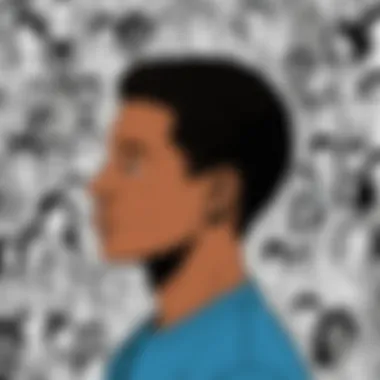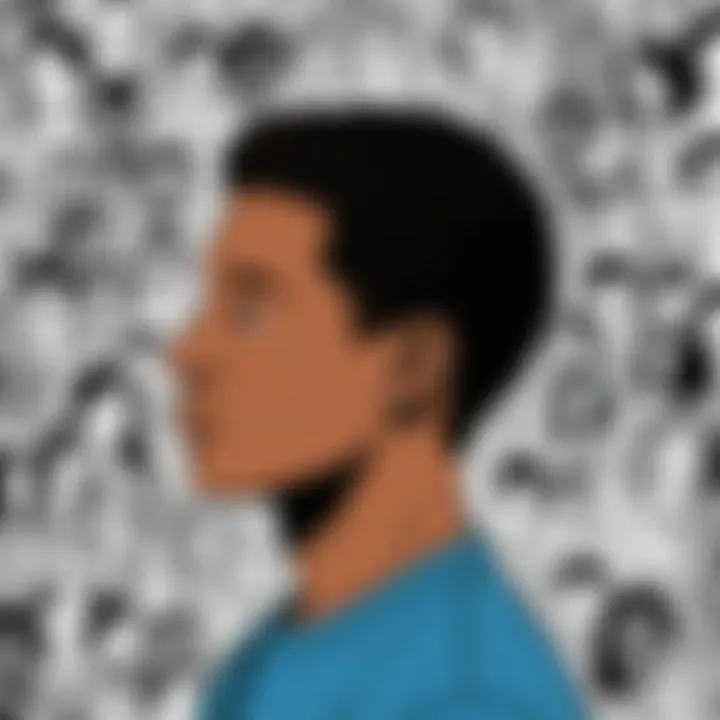Exploring Comics About Depression: A Visual Discourse


Intro
Comics have long been regarded as a unique medium, merging art and narrative to deliver engaging stories. This article explores how comics delve into the sensitive issue of depression. By examining various works and artists, we intend to uncover how these visual narratives contribute to the understanding of mental health. The visual representation of depression allows audiences a glimpse into the complexities of such a personal struggle. It fosters empathy, encourages dialogue, and can validate experiences for those who might feel isolated in their battles with mental health.
Although comics often tackle a wide array of topics, their approach to depression stands out for its ability to illustrate profound feelings in a way that words alone cannot capture. The blend of imagery and text creates a visceral experience, engaging readers on multiple levels. Through this examination, we will highlight key works, the artists behind them, and the broader cultural implications of comics as a medium discussing depression.
Technology Insights
As the landscape of comic creation evolves, technology plays a critical role. Digital tools have democratized the field, allowing a wider range of voices to contribute to the discourse on depression. Software like Clip Studio Paint and Adobe Illustrator enable artists to experiment with styles and techniques that enhance their storytelling.
Latest Tech Trends
The rise of webcomics and apps dedicated to comic reading offers new platforms for artists. This shift has made comics more accessible, reaching audiences who might otherwise not engage with print media. Comic platforms such as Tapas and Webtoon have emerged, hosting numerous narratives that tackle mental health topics, including depression.
Innovation in Tech
Moreover, technological advancements allow for interactive storytelling. Artists can now integrate multimedia elements into comics, creating an engaging experience. Animations or soundscapes accompanying graphic narratives deepen emotional impact. As artists explore these tools, they push boundaries and challenge traditional perceptions of what comics can achieve in expressing mental health issues.
Representation in Comics
Comics are a reflection of the societies we inhabit. They showcase diverse experiences centered on depression, diversifying the narrative that often surrounds mental health. Artists such as Aline Kominsky-Crumb and Norwegian cartoonist Jason have changed how we perceive these topics. Their works resonate with established narratives while introducing new perspectives.
Significance of Representation
Representation matters greatly. It influences how society views mental health. When varied experiences of depression are illustrated, it breaks down stigma and fosters connection. Readers find comfort in knowing their feelings are mirrored in the stories of others, particularly when those stories are presented with authenticity.
"Comics can serve as a mirror, reflecting the narratives of those who feel unseen in everyday discourse."
Narrative Techniques
Comics utilize diverse techniques to convey complex emotions. Artists can employ symbolism, color theory, and pacing to articulate experiences of despair or hope. Each element contributes to how a reader interprets the narrative.
Artistic Choices
For instance, the use of muted colors may evoke feelings of sadness. In contrast, bright hues could symbolize moments of clarity or recovery. Through pacing, artists can manipulate how tension builds, influencing emotional responses. These techniques are not merely artistic choices; they embody the very essence of expressing mental health struggles.
Finale
Prolusion to Comics and Mental Health
Comics have long served as a bridge between complex themes and more accessible formats for audiences of varying backgrounds. The focus on mental health, particularly depression, is critical in today's discourse. By intertwining visual storytelling with poignant narratives, comics allow for nuanced considerations of mental experiences that are often overlooked or misunderstood in conventional media.
One core benefit of exploring comics related to mental health is their ability to convey emotions and situations in a way that can resonate deeply with readers. Individuals grappling with depression may find comfort in seeing their struggles represented visually. By bringing these issues to the forefront, comics foster a sense of community and understanding.
Understanding Depression
Depression can manifest in various forms, impacting thoughts, feelings, and behaviors. It is often characterized by persistent feelings of sadness, hopelessness, and lack of interest in activities. Awareness of these symptoms is crucial not only for those experiencing them but also for those who seek to understand and provide support.
The portrayal of depression in comics serves to demystify the condition. Creators use their art as an accessible medium to articulate the often complex feelings associated with mental health challenges. Comics provide a language that is less intimidating and more engaging than traditional formats, enabling readers to explore these themes.
The Role of Comics in Art and Communication


In the landscape of art and communication, comics hold a distinctive place. They combine visual elements with written narratives, creating a hybrid form that can articulate complex ideas concisely. This format is particularly effective in communicating themes surrounding mental health, as visual cues combined with text can effectively depict emotional complexities.
The engagement of comics in discussions about depression serves several purposes:
- Visual Representation: Images can evoke immediate emotional responses, often faster than text alone.
- Accessibility: Comics are easier to digest for individuals who may struggle with traditional literary formats.
- Broader Audience Reach: Comics can attract diverse audiences, breaking down barriers often present in discussions of mental health.
Comics facilitate conversations that may be otherwise difficult, allowing for a more profound understanding and connection to the themes of depression and mental health.
This unique blend of art and communication underscores the importance of comics in mental health dialogues. They create a platform where individuals can express their experiences and where readers can find solace and understanding.
Historical Context of Comics on Depression
Understanding the historical context of comics addressing depression is crucial for a thorough appreciation of their evolution and significance in society. Comics have long served as a medium to convey complex emotions and experiences. This section elaborates on how early representations have shaped modern narratives and the transformative experience in comic art.
Early Representations of Mental Health
Historically, mental health has been a taboo subject. Early comics often depicted mental illness in a simplistic or exaggerated manner. Characters labeled as 'mad' or 'insane' appeared in various formats, frequently reinforcing negative stereotypes. This portrayal did not delve into the nuances of mental health; rather, it used humor or horror to entertain. Such representations lack depth and fail to convey the genuine struggle many individuals face with conditions like depression.
The comic strips of the early 20th century saw characters who were melancholic but rarely explored or articulated their feelings. For example, the Crazy Cat series, while popular, employed surreal themes without offering an insight into the characters' psyches. This lack of depth can lead one to question the societal understanding of mental health during that time.
It wasn't until the late 20th century that comics began to tackle depression more thoughtfully. Artists started to reflect personal experiences, using their platforms to express vulnerability and foster dialogue. The shift indicated a growing awareness of mental health issues in artistic communities and beyond.
Evolution of Themes in Comic Art
As time progressed, the themes within comics evolved alongside societal attitudes toward mental health. The late 20th century marked a pivotal moment when creators began addressing depression more authentically. Comics like Persepolis by Marjane Satrapi offered first-hand accounts of personal trauma and resilience. Such works paved the way for deeper explorations into the emotional landscapes of characters.
Current comics blend visual art with poignant narratives. They explore various themes such as isolation, struggle, and recovery. For instance, Fun Home by Alison Bechdel provides insights into her own family life intertwined with her battles against depression and identity. Comics now present depression not as a caricature but as a legitimate struggle that deserves dialogue and understanding.
In contrast to earlier representations, modern works utilize symbolism and nuanced storytelling to de-stigmatize depression. This shift indicates a more profound recognition of mental health as an issue that affects many people. Comics have transitioned from mere escapism to forms of self-expression that can educate and promote empathy.
"Comics provide a unique lens through which we can examine the complexities of the human condition, enabling readers to connect on a deeper level with the narratives presented."
As we move forward, it's evident that comics play an essential role in changing the discourse around depression. Their evolution mirrors broader societal changes, showing a clear trajectory towards understanding and compassion.
Key Themes in Comics Addressing Depression
In exploring comics that tackle depression, one encounters several key themes that emerge consistently across different works. These themes are vital as they help to illuminate the experiences of individuals battling mental health issues. They provide readers with a lens through which they can better understand the complexities of depression, enhancing empathy and reducing stigma surrounding the subject.
Isolation and Loneliness
Isolation is a prevalent theme in comics addressing depression. Whether it is expressed through the starkness of the illustrations or the solitary actions of the characters, the feeling of being alone in one’s struggles is palpable. This theme resonates deeply with readers who often feel alienated by their experiences.
For instance, in "Marbles: Mania, Depression, Michelangelo, and Me" by Ellen Forney, we see a juxtaposition of vibrant images with darker tones to signify the duality between manic highs and depressive lows. Graphical representation of isolation can be stark, capturing how loneliness can lead one to withdraw from social circles and support systems. This portrayal fosters a kinship among those who suffer in silence.
Coping Mechanisms and Struggles
Another significant theme is the exploration of coping mechanisms and the various struggles associated with them. Comics often depict characters using diverse methods to manage their illness, ranging from therapy sessions to creative outlets, such as drawing or writing.
For example, in "Check, Please!" by Ngozi Ukazu, the protagonist utilizes hockey as an escape, showcasing how physical activity can serve as a coping strategy. This illustrates not only the journey of dealing with depression but also the nuanced ways individuals find relief, confronting the challenges head-on. By presenting these coping mechanisms, comics empower readers to seek help or explore their own strategies.
Hope and Recovery Narratives
Finally, hope and recovery are pivotal themes that can shift the tone from despair to resilience. Comics adeptly convey narratives that balance the struggles with light at the end of the tunnel. Characters often undergo profound transformations, symbolizing growth and recovery despite the ongoing challenges of living with depression.


In "I’m Sorry: A Story of Consolation" by Nicole J. Georges, the narrative shifts focus towards recovery, exploring difficult moments but ultimately emphasizing the importance of community and support. This theme not only provides a sense of hope for readers, reinforcing that recovery is attainable, but also encourages open dialogue about mental health.
"Comics serve as a powerful medium to destigmatize and shed light on the experiences of individuals with depression."
By emphasizing these themes—isolation and loneliness, coping mechanisms and struggles, and hope and recovery narratives—comics create a multifaceted discussion around depression. They act as bearers of stories that bring clarity and understanding, making complex emotions and experiences more relatable and accessible to a broader audience. Through these narratives, readers can find solace and a sense of community, which is essential in conversation about mental health.
Influential Comics and Graphic Novels
The exploration of comics addressing depression reveals impactful narratives that resonate deeply with readers. Comics and graphic novels serve as a unique medium to convey mental health issues due to their visual and textual combination. This art form allows for nuanced storytelling, creating connections that traditional literature might not achieve as effectively.
Comics address complex emotional landscapes while providing direct engagement from the audience. They often attract readers who might not otherwise engage with purely textual narratives on mental health. The visual elements can present feelings and experiences in a way that words alone cannot, making them a crucial element in discussing depression.
"Comics can touch upon the silent aspects of depression, making the invisible struggles visible in an impactful way."
Specific Works That Resonate
A few notable comics have emerged as essential readings for understanding depression. One such work is "Fun Home" by Alison Bechdel. This graphic memoir explores Bechdel's relationship with her father and her own identity struggles. Its rich visuals and personal narrative help demystify depression, allowing readers to engage with issues of mental health on a personal level.
Another significant title is "The Complete Maus" by Art Spiegelman. Through an allegorical narrative about the Holocaust, Spiegelman addresses not only historical trauma but also personal depression and its inherited effects. This graphic novel underscores the complexities of trauma and survival, demonstrating how historical events can contribute to mental health issues across generations.
Additionally, "Hyperbole and a Half" by Allie Brosh combines humor with serious discussion of depression. Brosh’s distinctive art style and storytelling allow readers to find solace and connection in shared experiences of mental ill health. This juxtaposition of lightheartedness and deep introspection emphasizes the multifaceted nature of depression.
Impact of Autobiographical Comics
Autobiographical comics have a unique ability to create an intimate connection between the author and the reader. When artists share their personal experiences with depression through comics, it sometimes breaks down barriers. Examples like "Persepolis" by Marjane Satrapi also illustrate how personal narratives can intertwine with broader cultural and political contexts. Satrapi reflects on her own life while simultaneously commenting on the impact of societal expectations on mental health.
These narratives provide authenticity that resonates with readers navigating similar experiences. The engagement with real-life stories often leads to a greater understanding and awareness of depression. Moreover, it encourages discussions not just about mental health but also about resilience and recovery.
In essence, influential comics and graphic novels play a pivotal role in representing depression. They don't merely tell stories; they evoke empathy, challenge stigmas, and enable dialogue about mental health issues in a way that is accessible and relatable.
The Intersection of Art and Therapy
Art is not just for aesthetic pleasure; it serves as a tool for expression, communication, and healing. This is especially evident in the realm of comics, which can merge storytelling with visual elements to create a unique and often therapeutic experience. Exploring the intersection of art and therapy provides insight into how comics can facilitate dialogue about depression and mental health.
The impact of creating art can be profound. It allows individuals to externalize their internal struggles. Through comics, artists portray their emotions and thoughts visually, making sense of what might feel chaotic or overwhelming. This reflective practice also helps in processing experiences that might be difficult to articulate in words. Comic creation can thus serve as a therapeutic outlet, allowing both creators and readers to explore feelings linked to mental health, particularly depression.
Art as a Reflective Practice
Creating comics encourages a deep level of introspection. Artists often translate their feelings into drawings and narratives, effectively turning their personal experiences into tangible work. This process can help individuals understand their mental state by seeing it represented visually. Such representation can provide clarity and foster self-discovery.
Reflective practices in art therapy enhance emotional regulation. When artists document their experiences through comics, they can gain insight into their emotional patterns. This understanding may not only help them navigate their feelings but also connect with audiences who share similar experiences. Important aspects of this process include:
- Self-exploration: Artists reflect on their own lives, leading to deeper understanding of personal issues.
- Connection: Comics can resonate with readers, fostering empathy and shared understanding.
- Catharsis: Artistic expression can be a form of emotional release, reducing feelings of isolation.
Therapeutic Benefits of Creating Comics
The act of creating comics offers several therapeutic benefits that contribute to mental health wellness. For many, the process of drawing and writing serves as a form of stress relief. Engaging in creative work can stimulate positive emotions, which are crucial in combating symptoms of depression. Specific benefits include:
- Enhanced mood: The creative process can elevate mood, shifting focus away from negative thoughts.
- Coping strategies: Artists can develop skills to cope with adversity through their narratives, providing insight into managing depression.
- Empowerment: Turning experiences into art can create a sense of agency, helping individuals reclaim control over their narrative.
Through comics, the bridge between art and therapy becomes evident. The exploration of such intersections not only enriches the medium itself but also amplifies the visibility and discussions surrounding mental health. As more creators engage with these themes, the impact on public understanding of depression continues to evolve, promoting empathy and openness.


Comics as a Tool for Stigma Reduction
The stigma surrounding mental health issues, including depression, has long hindered open discussions and understanding. Comics can serve as a powerful tool for stigma reduction. Through relatable characters and narratives, comics normalize conversations about mental health. They make complex emotions and experiences accessible to a wider audience, fostering empathy and understanding.
Normalizing Mental Health Discussions
Comics present a unique platform for normalizing mental health discussions. The visual format often captures attention in ways traditional text may not. Readers find it easier to engage with stories illustrated in panels rather than academic or clinical descriptions. This engagement can demystify mental illness.
By presenting characters grappling with feelings of sadness, hopelessness, or anxiety, comics portray these struggles as common human experiences. Readers often see themselves reflected in the characters’ challenges. This reflection helps de-stigmatize feelings that many individuals experience but may be afraid to discuss.
Additionally, popular comics such as "My Depression: A Picture Book" by Elizabeth Swado or "The Adventures of a Mind" by Ellen Forney explicitly address depression. These narratives encourage open conversations by depicting mental health not as a taboo topic but as a part of life. When readers see these subjects openly discussed, they are more likely to feel comfortable sharing their own experiences.
Community Building through Shared Experiences
Another significant aspect of comics is the way they facilitate community building around mental health. Readers often connect through shared experiences depicted in comic stories. This sense of community fosters support and understanding among individuals who may feel isolated due to their mental health struggles.
Online platforms, such as Reddit and Facebook, allow discussions around specific comics. Communities form around various works. Readers can share personal stories that resonate with the narratives they see in comics. These environments become safe spaces for individuals to express their feelings and experiences.
Moreover, this communal aspect encourages collective healing. People gain strength by recognizing they are not alone in their experiences. Many find solace in discussing stories that accurately represent their own struggles. In this way, comics do not merely entertain; they create connections that reduce isolation and encourage dialogue around mental health.
Comics, often seen as mere entertainment, transcend their initial purpose to become vital instruments in the fight against mental health stigma.
Future Directions for Comics on Mental Health
The landscape of comics addressing mental health, particularly depression, is poised for significant evolution. The importance of exploring future directions in this field lies in understanding the potential new narratives and representation strategies that can emerge. By delving into this area, we identify not only the creative potentials but also the critical role these narratives play in shaping public perception about mental health issues. The advancement of technology and social media platforms can further amplify the voices of creators and the stories they wish to tell.
Emerging Artists and New Narratives
In recent years, there has been a notable influx of emerging artists who bring fresh perspectives and innovative techniques to the comic medium. Their works often reflect personal experiences with depression and mental health, providing authentic insight that resonates with readers. These creators are not just observing the dialogue; they are actively contributing their narratives that challenge the established norms within the industry.
New narratives focus on varied experiences, transcending traditional depictions of depression seen in earlier comics. Artists are exploring themes such as intersectionality, the role of technology in mental health, and the complexities of coexistence with a mental health condition. The impact of new narratives may foster an environment where those suffering from mental illness see their realities reflected, giving them a sense of belonging and understanding.
Expanding the Scope of Representation
The need for expanding representation in comics about mental health cannot be overstated. Historically, depictions have often struggled with stereotypes and one-dimensional portrayals of depression. There exists a rich tapestry of experiences connected to mental health; hence, including diverse voices is essential. This effort should focus on the contributions from various communities, including different ethnicities, genders, and age groups.
By moving beyond the majority experiences, comics can offer a fuller picture. For instance, exploring how cultural background alters the perception and experience of depression provides depth to the discourse. It encourages readers to recognize the shared struggles and unique challenges that may not be immediately visible.
Furthermore, as public discourse on mental health expands, so do the responsibilities of comic artists. They must handle these sensitive topics with accuracy and empathy, avoiding potential misunderstandings or stigmas.
"Art can be a powerful means of expressing what is often difficult to articulate."
These future directions signify that comics will likely continue to play a vital role in mental health discussions. The commitment to evolving representation and narratives will be crucial in fulfilling the potential of comics as agents of change.
Culmination
The exploration of comics that address depression holds significant relevance in today’s society. Art forms that tackle mental health challenges can facilitate understanding and conversation around these topics. Importantly, comics serve as a bridge, connecting complex emotional landscapes to a broader audience who may struggle to articulate their experiences.
The Lasting Impact of Comics on Mental Health Awareness
Comics play a critical role in enhancing mental health awareness. They offer unique narratives that reflect the nuances of living with depression. Through characters and their journeys, readers can see their own struggles mirrored back to them, creating a sense of connection and understanding. These visual narratives are not just illustrations; they are representations of real-life experiences that resonate deeply.
In many cases, comics help to demystify depression. They challenge the stigma surrounding mental health by depicting honest and relatable experiences. Readers may find solace in stories that normalize their feelings, promoting healthier dialogues around mental illness.
Moreover, comics can educate audiences on the symptoms, challenges, and coping strategies associated with depression. By combining visuals with poignant storytelling, they engage readers in ways that traditional text may not. This is particularly crucial for younger audiences who might be more inclined to engage with visual content rather than dense academic literature.
"Art can help us to articulate what often feels unnameable. Comics provide this unique lens into the world of mental health, shaping perceptions and providing hope."
Furthermore, the impact of autobiographical comics adds a personal touch that can lead to deeper insights into the lived experience of individuals facing mental health challenges. Artists like Ellen Forney and Catana Chetwynd create works that resonate strongly, making complex feelings more accessible to readers.







